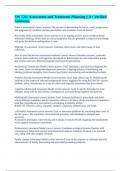SW 724: Assessment and Treatment Planning || A+ Verified
Solutions.
What is assessment? correct answers "the process of determining the nature, cause, progression,
and prognosis of a problem and the personalities and situations involved therein"
Key points about assesments correct answers It is an ongoing process and is evidence-based.
Inferential thinking, which leads to clinical judgments that are grounded in empirical knowledge
and guide the decision making about a case.
Methods of assessment correct answers Listening, observation, and other means of data
collection.
How do you find the best assessment methods? correct answers Narrative reviews, systematic
reviews (meta-analysis), and regestries developed by federal agencies and independent groups
that reviews and rates different programs/interventions/instruments.
Psychosocial Assessment Model correct answers Goal: determine a psychosocial diagnosis for
the client; factors in history/developmental processes. Ongoing process of identifying and
labeling problems/strengths. Uses classical psychiatric interviewing and standardized testings.
Problem-Solving Assessment Model correct answers Goal: help clients cope by identifying the
problem in the context of relevant intrapersonal issues, suggested by using the Four Ps—person,
problem, place, and process, as a way to collect and organize assessment data from clients.
Coginitive Behavioral Assesment Model correct answers Goal: to specify the behavior to be
changed, along with its antecedents, consequences, and underlying cognitive mechanisms.
Multiomodal Assessment correct answers Goal: evaluate problems in great depth and detail
across different modalities, and the interactive effects of all these. Helps practitioners formulate a
brief but comprehensive assessment by developing a modality profile.
BASIC ID: behavior, affect, sensation, imagery, cognition, interpersonal, and drugs.
Life-model Assesment correct answers Goal: to determine problems by examining three areas of
the life space—life transitions, environmental pressures, and maladaptive interpersonal
processes.
Assessment techniques: interviewing and ecomaps or social network mapping and standardized
social support assessment instruments
Ecobeavioral Assesment Model correct answers Combines ecological systems theories with
contemporary behavioral practice from behavioral analysis traditions. Ecomap is an essential
tool, along with other graphic methods
Family System ASsesment Model correct answers Focus on the systemic or relational network
characteristics of family functioning and associated presenting problems.
, o Must use assessment methods that focus on the interactive sequences and relational network
characteristics of the entire family.
Techniques include: circular questions; conversational or therapeutic questions; hypothesizing;
circularity, and neutrality; tracking problems, solutions; or exceptions to the problems; and
pretherapy change assessment.
o Graphic tools such as genograms
Task-Centered Assesment Model correct answers Goal: specify target problems and their desired
outcomes
Designed to be open to integrating various theoretical and technical orientations
First activity is initial problem formulation.
Second, the practitioner then places it in the context in which it occurs.
Strengths Perspective in Assessement correct answers This incorporates a value system that
encompasses belief in the dignity and worth of individuals, their self-determination, and the
transformative power of humans and human relationships.
Solution-Focused Brief Therapy correct answers Assessment is part of the intervention process.
Practitioners assess in each particular case who is motivated to change. This assessment is
guided by a case construction process that helps practitioners think about who is the customer,
complainant, or visitor.
SFBT offers a wealth of questioning techniques that can help facilitate client assessment and
change.
Practitioners focus on exceptions to the problems, strengths, and competencies of clients instead
of on their weaknesses and pathologies.
Four reason to collect quanatative measures on client behaivors as part of the assesment process?
correct answers Help improve treatment, contributes to clinical research, provides a basis for
practice evaluation and accountability, and increases skills repertoire.
Client Self Recording and Self-Mointoring: Strengths correct answers Most commonly used,
enables practitioners to obtain baselines measures of client problems, can explore
severity/frequency, and can be used in supplement to clinical judgement.
Client Self Recording Self-Mointering: Weakness correct answers Not rigorous scientific forms
of quantitative measurement.
Self-Anchored and Rating Scales: Strengths correct answers Often necessary when a
standardized instrument is not available; scores on scales can be used to assess the problem and
monitor its change over the course of treatment; scale scores are relevant and practical; scales
help clients define the problem; systematic way for clients to observe their thoughts, feelings,
and behaviors.
Self-Anchored and Rating Scales: Weaknesses correct answers Not rigorous, scientifically, valid,
or reliable.




